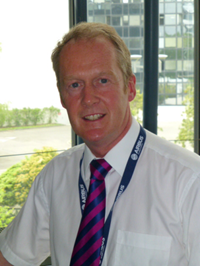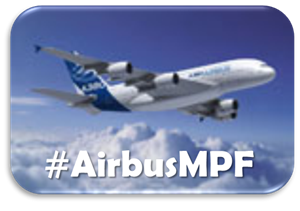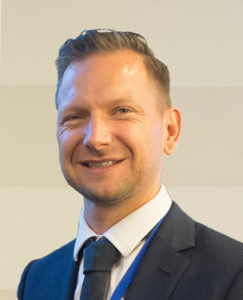Interview with Mark Robinson
 Mark Robinson is Head of PM People and Governance at Airbus, he has helped drive a sustainable change in PM culture across the business and improve the overall competencies of the PM population. Mark looks back on the past few years at Airbus and recognises a significant change within his business environment.
Mark Robinson is Head of PM People and Governance at Airbus, he has helped drive a sustainable change in PM culture across the business and improve the overall competencies of the PM population. Mark looks back on the past few years at Airbus and recognises a significant change within his business environment.
“Go back five or six years and we were benchmarking outside of Airbus,” he explains. “We have gone through a real business transformation step by step and in some areas without even knowing it and that is best sometimes. Companies are now coming to us as they see what we are doing in Project and Programme Management and using us as a benchmark.”
But as Mark explains it wasn’t always the case.
“Go back in history at Airbus when we had share price impacting issues involving our now flagship aircraft, the A380. Developing a new aircraft means you are betting the company as you are spending over 10bn euros – it’s a huge complex project to manage. We realised we had to do things differently and so we did.”
The levers of change
“The real levers for change came after the publication of two influential reports in 2007/08, one by Deloittes the other by the US government accountability office. They assessed why their Aerospace and Defence contracts were late and over budget and analysed five route causes. These included programme management challenges, technical complexity issues, talent shortage, supply chain challenges and politics.”
“In Airbus we had many of these same issues,” adds Mark. “The talent shortage was a key driver for Airbus both in project management and systems engineering as were the supply chain challenges, as over 60 % of our work is in the supply chain and that is really key to making the project a success.”
Mark found that there was no supported PM or PMO development path. “In Airbus, PMO is both an organisation (project and programme office) and a role (project management officer). It became clear that we needed to drive a dedicated development path for our PMOs and Project leaders and also at the same time improve the integration of process methods and tools. The vision was to create a sustainable cultural change.”
Launch of Centre of Competence for PPM
In 2009 a Group wide PM Improvement Programme was launched and as part of this Airbus set up a Centre of Competence for Project and Programme Management with a vision to create a sustainable cultural change.
Mark explains. “We had tried to deliver this before but it never got the right level of attention, this time around the vision was backed up with the attitude that we are going to ensure we deliver. “There was a budget and resource to support it and there was board level sponsorship. It came from the very top.
“It was essential that it was sponsored at board level. A lot of senior people thought that they should personally support and move it forward rather than treat it as another initiative and risk losing the momentum.” Airbus recognised that culture change would take time but saw it as an integral way of working in the future.
Mark adds: “It was always a long term vision. To support this we set up the Airbus Group PM Council and a Steering Board as well. The role of those was to sponsor the change but also to set the strategic direction and harmonise group policies on project and programme management which we hadn’t really done before across the whole group.
Project Categorisation and PM Certification
Two initial key drivers we then launched to support this were Project Categorisation and PM Certification. This was not just symbolic but a clear sign that we believed in what we were doing “
Project Categorisation is an agreed Airbus Group policy, mandated across the business. It assesses any project against 16 weighted criteria, looking at elements like project complexity, risk and the overall project challenge. The priority is to assess the Projects prior to launch because the result drives other processes including PM Certification, and Earned Value Management implementation.
Mark says: “We did some outside benchmarking with some companies such as Siemens and then put that into our own business context so it made sense for Airbus.
 “So we assess the different elements looking for objective evidence and enter the results into a model. From this we get a score which determines the Project Category based on five levels – Iron, Bronze, Silver, Gold and Platinum. Each assessment is reviewed by an independent panel before the Category is formally assigned.
“So we assess the different elements looking for objective evidence and enter the results into a model. From this we get a score which determines the Project Category based on five levels – Iron, Bronze, Silver, Gold and Platinum. Each assessment is reviewed by an independent panel before the Category is formally assigned.
Mark believes that because of the collaborative nature of the categorisation process project leaders gain a better understanding of the Project itself.
How it works in practice
“We don’t just look at the budget but review the complexity of supply chain, maturity of the technology, etc. and it gives a really good view of the project from different angles and people do really learn a lot from the process. At first people saw it as a compliance thing – which they had to do it – but the feedback that we get from project leaders and PMO’s is that it really does add value.” It identifies what we know but more importantly what we don’t know and that is where we need to put our energies.
However, it was the introduction of the PM Certification that proved to be the real enabler for cultural change across the business.
Mark explains: “We spent a huge effort in benchmarking and developing our own model which is fully aligned with the Project Categorisation process. “We have five different levels of PM certification which looks at the individuals experience in project management, product and technical management, multi-function and multi-cultural experience and also the finance and business related experience. What differentiates this is that we don’t just look at project leaders and PMO’s on our Aircraft Programmes but the wider population too. For example we actively encourage Engineers, IS/IT Project leaders and business change project leaders to be involved.”
The PM’s personal dossier
Each applicant fills in a personal dossier as part of the scheme. Airbus deals with around 50 dossiers a month and by September of this year should have 2,000 people having gone through the process.
“There is no pressure to complete a dossier in a given time period it depends on the individual, their experience training and career path to date,” explains Mark. “The dossier is then formally assessed by an independent panel who either grants the person a specific Certification level or sometimes a level is suggested but advises them what gaps they need to fill before a Certificate can be granted. This could be through additional training for example.
Once certified they become part of our PM Professional Certification population.
At the start it was not easy. We had a huge stakeholder management exercise and many communication events. People needed convincing. However this was not just a ‘one off’.
We still ensure individuals are supported when going through the process to allay any fears they may have and we still are continuing to communicate at every level including reporting to the Airbus Group PM Steering Board.
“We aim to be very people focused and once individuals go through the certification scheme this is linked to a development plan – what do you need to do to get to the next level and what is the career path within the business? We work very closely with our HR colleagues. “What we are trying to do now is match the project category to the certification levels of the individuals. At first people were nervous they thought that if they didn’t get the right level of certification would they still be the project leader? This is certainly not the case but for new Projects Certification is really an entry criteria so when we advertise for a new role we now put the certification level required.
“On some of the major Programmes the heads of Programme and chief engineers are now certified – it’s leading by example and that has really changed the behaviour and the mindset within the company and makes it easier to drive the change.”
The role of the PMO
One area the business recognised a need for change was the role and perception of the PMO. With currently around 650 PMOs deployed around the business, Airbus thought it was vital to raise their professional standing.
“People were recruiting PMOs across the business and calling them PMOs but they weren’t really doing the PMO job. What we did was bring the PMO population under the umbrella of the Centre of Competence and create a clear job description with associated competencies.
One of the key drivers for this was that we increase the ‘make/buy’ ratio. Historically in some areas the ‘make’ was 20 per cent and the ‘buy’ was 80 per cent, so we had a huge turnover of people and were losing the skills and capabilities of the individuals.
The ‘make/buy’ is now around 50/50 and we partner with just three different companies for the supply of our PMO resource – more of a strategic partnership – to raise the skill level of our PMO population and the role itself.
We are very strict now, if someone wants a PMO we approve what they are doing through a clear job description or for external resource through a work specification which is formally validated.
We have taken away the perception that the PMO is just a project administrator but more of a navigator or rally driver. We are driving a real profession and a supportive career/development path. We still have a way to go but it’s a real success story.”
Sharing PM Knowledge
To support our PM population we have brought together the shared PM knowledge for Project, Portfolio and Programme Management into our PM @ Airbus Guidebook. This year we have just launched our Version 2 printing 5000 hardcopies but also complemented by an electronic flipbook version. Together with the electronic PM reference library which contains all the PM Standards, templates and best practice examples this really helps to reduce the learning curve effect especially when people move from one project type to another and has now become our bible.”
Another of Mark’s roles at Airbus is head of the Airbus Group PM Academy. This year alone the Aircraft side of Airbus is training 6,000 different people from across the business in various elements of Project, Programme and Portfolio Management with an increasing emphasis on behavioural training.
Mark adds: “Four years ago we would do more of the hard skills training – training in the tools etc. Where we are focusing now and moving ahead in the future with the Human side of PM. As part of our PM certification scheme we also have mandated a broad range of training that people need to do so they get a wider view of PM for example contractual management, supply chain management, configuration management.
PPM Qualifications
I was in Tokyo recently for a conference and all the delegates were wearing badges saying they were a PMP professional. Everyone thought that was the highest qualification in project management so I said to them in the presentation that the PMP is important as is the APMP for APM and we recognise both, but they are just one element at our bronze level certification. It puts it into a little bit of context, we want the more rounded individual as well and the qualification is just one element.
The launch of the Development Centre for Project Management (DCPM) is another key area of development. Devised to run eight times a year with 12 individuals at a time and sponsored by the Airbus Group PM Council it’s all about the individual’s personal development.”
Mark adds: “It’s a development centre not an assessment centre which is quite important. People come to the centre by nomination, but they must have completed their PM certification. We are not assessing them for promotion we are looking at how they can improve their own personal development.“
Alongside the DCPM, Airbus also runs workshops known as PM Adventure which targets both project management and change management professionals.
“The focus here has is on our bronze level within our PM certification scheme whereas the DCPM is targeted at silver level. Before the workshop each participant has an emotional intelligence test which looks at different elements including self-awareness, assertiveness, self actualisation etc. They get individual confidential feedback from this and then work as part of a business simulation for a fictitious company. Each person is given intensive peer feedback and then after the two days can transfer the learning straight back into the business. We also help them create their own personal development plan.
To complement the above we have set up a partnership (initially in France) to launch a Masters Degree in PM built upon the competence model of the industrial partners (technical and soft skills). This will be available across the whole Airbus group as a fast track for:
- Engineers who wish to move into PM
- Project Leaders and PMO’s who need to increase their competencies”
Business Change at Airbus
Mark believes that Airbus is leading the way in business change with the development of its Leaner Business improvement Project plus (LBIP+) methodology, launched in March.
Mark says: “From all my experience I don’t know any other company that has integrated project management, lean management and change management together in one methodology. LBIP+ is another key lever for us – it’s a methodology. We have a lifecycle and it is supported by specific competence, for example, the leaders of a business improvement project need additional competencies in change management. So now we have recognised that the people running business improvement projects may need a slightly differentiated learning solution.
Within the methodology there is a dedicated lifecycle and interactive e-site, Blended Learning, gate review checklists, tool kits for PM, Lean and Change Management. Importantly we have the ability to tailor the approach to the complexity of the Project.
 We probably run at any one time 2,000 business improvement projects. These range from local improvement to major Transformation Platforms where you are looking to save over 1bn euros and you need good project and programme management practices to do that.
We probably run at any one time 2,000 business improvement projects. These range from local improvement to major Transformation Platforms where you are looking to save over 1bn euros and you need good project and programme management practices to do that.
So it’s really an holistic approach and it is now mandated throughout Airbus. We have a momentum now, we work very closely with the lean academy and the lean guys. It is really powerful.
To capitalise on the learning we also have a dedicated Community of Practice (CoP) where we bring together practitioners from around the business to share good practices, lessons learned and to animate the network.
Moving forward we aim to keep up the momentum. We do recognise that the business is changing from major new Aircraft Developments to more incremental developments such as our A320 and A330 NEO projects. Time to Market is key. We have production ramp ups to manage and a widening Industrial footprint such as our new Final Assembly Line in Mobile Alabama. Speed, Simplicity and Agility is required in everything we do and I believe with the enhanced competencies of the PM population we are ready to deliver.”
 Mark has now teamed up with Steve Wake from eVaintheUK to organize a show-case two day conference in Toulouse on 23rd & 24th October called Making Projects Fly. During this event more than 100 delegates, drawn from across Airbus and elsewhere to share experience and good practices learn how to build still better P3M professionals together.
Mark has now teamed up with Steve Wake from eVaintheUK to organize a show-case two day conference in Toulouse on 23rd & 24th October called Making Projects Fly. During this event more than 100 delegates, drawn from across Airbus and elsewhere to share experience and good practices learn how to build still better P3M professionals together.
Listen to Mark’s presentation at #eva19
[PM Channel Archive]
 Silvia is a BIM Consultant at CH2M, an engineering company that provides consulting, design, construction, services and operation for any kind of project.
Silvia is a BIM Consultant at CH2M, an engineering company that provides consulting, design, construction, services and operation for any kind of project.

 “So we assess the different elements looking for objective evidence and enter the results into a model. From this we get a score which determines the Project Category based on five levels – Iron, Bronze, Silver, Gold and Platinum. Each assessment is reviewed by an independent panel before the Category is formally assigned.
“So we assess the different elements looking for objective evidence and enter the results into a model. From this we get a score which determines the Project Category based on five levels – Iron, Bronze, Silver, Gold and Platinum. Each assessment is reviewed by an independent panel before the Category is formally assigned.








 Emma-Ruth Arnaz-Pemberton
Emma-Ruth Arnaz-Pemberton




 These programmes involve working closely with client organisations and participants to understanding their potential for development and growth through to realising these opportunities. This role also includes engaging teams of faculty and experienced practitioners to create the design and content required to ensure an engaging learning experience.
These programmes involve working closely with client organisations and participants to understanding their potential for development and growth through to realising these opportunities. This role also includes engaging teams of faculty and experienced practitioners to create the design and content required to ensure an engaging learning experience.